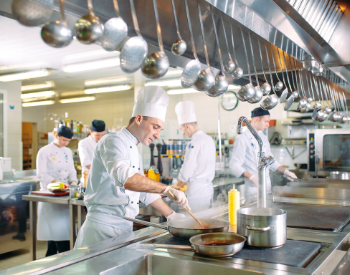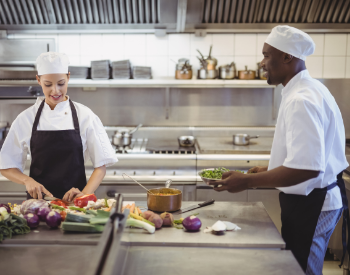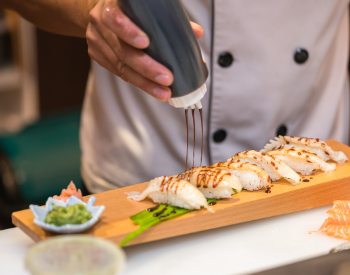Every detail and step taken in your restaurant's kitchen counts. How fast your staff can get orders out of their kitchen is often what makes or breaks a dining experience for guests. Operators understand the importance of a well-functioning kitchen, but it can be overwhelming to organize a kitchen for everyday use.
Putting together the basics for a commercial kitchen seems like it might be enough to manage your restaurant, however, when a kitchen is not well put together it could cause endless delays in the long run.
Poorly designed kitchens lead to frequent accidents between staff such as bumping into each other and dropping plates. Food preparation takes extra time and mismatched orders or avoidable mistakes often happen in a disorganized kitchen.
When a restaurant’s kitchen is not laid out efficiently, you could be missing out on extra space which could be used to your advantage. Whether you’re building a commercial kitchen from scratch or want to renovate your restaurant’s kitchen, designing your space in an efficient manner is essential for keeping customers happy and your business running smoothly.
What Is An Efficient Kitchen?

An efficient kitchen is a kitchen that is strategically designed to enable back-of-house staff to work in a consistent and productive manner. In an efficient kitchen, the distance between workstations and appliances is minimized, food preparation is streamlined, and orders are prepared in a faster manner without overexerting your team.
A well-managed kitchen is one that is well planned and designed for efficiency. Any commercial kitchen can be adjusted to run more efficiently with a few simple steps.
5 Ways To Run Your Restaurant Kitchen More Efficiently
The idea of running a restaurant’s kitchen more efficiently is appealing to staff and operators alike. Even the smallest of details matter, and finding ways to improve your kitchen’s dynamic will help streamline productivity at your restaurant.
Through updated layouts and workstations, you can make changes that upgrade your commercial kitchen’s organization and structure for the better. Below are 5 ways to help run your restaurant kitchen more efficiently.
1. Rethink Your Kitchen Layout
The most important step you can take to improve your commercial kitchen is by creating an efficient kitchen layout from the start. A well-organized space allows staff to move throughout the kitchen easily and find what they need to prepare meals without much effort. To turn your restaurant’s kitchen into an efficient one, consider keeping the distance between workstations and appliances as short as possible without causing strains in mobility.
Think of the space between your stove, sink, and fridge as a triangle. The distance between each area should all be within reach from each other, with enough space so that your staff doesn’t feel cramped together. You should be able to move freely through the triangle formed by your sink, stove, and fridge without having to take too many steps in between.
Even if you can’t change some more permanent aspects of your kitchen, you’ll still be able to arrange parts of your kitchen efficiently. If you have movable workstations, consider using them to adopt a triangle-like layout in your kitchen. Place workstations in points that are adjacent to your kitchen’s sink, fridge, or stove.
2. Set Up An Efficient Inventory System

Maintaining an efficient inventory system is essential to improve your commercial kitchen. A good inventory system helps your employees avoid mistakes and keep track of what ingredients need to be restocked or what is going to waste. Having ingredients out of order or difficult to access during lunch or dinner rushes could be detrimental to your customers’ dining experiences.
Set up an efficient inventory system by tracking your inventory on a daily or weekly basis. Designate one of your staff members to take your kitchen inventory, and rotate staff in this role as needed. By consistently taking inventory, you’ll find what ingredients need to be replaced or prepped often, and what ends up going to waste. Labeling your inventory will make finding specific ingredients much easier. Storing inventory on shelves or in a visible, easy-to-reach area near workstations will help streamline order preparation.
The FIFO method, or first in, first out method allows you to organize your inventory system in a way that minimizes food spoilage and waste. Place and label items received first at the front of your dry storage, shelves, or freezer and sort items received later in the back of them. Label inventory items by date and create a sheet for food waste so you can track when inventory goes bad.
3. Create Efficient Work Stations
Your commercial kitchen’s workstations are where back-of-the-house staff spends most of their time working. Dividing a kitchen into designated workstations is an effective way to keep your restaurant running smoothly.
An efficient kitchen features 5 different workstations:
- Preparation
- Cooking
- Cleaning
- Food Storage
- Non-Food Storage
Each workstation should be placed in an area of your kitchen that corresponds to its specific purpose. For example, your cleaning station should be placed near your sink and dishwasher, your preparation station placed near your fridge or inventory area, and your cooking station should be placed near stovetops or larger kitchen appliances. Keep perishable, frequently used items in your food storage station and miscellaneous items like containers or extra takeout supplies in your non-food storage station.
Properly set up each station by equipping each area with all the inventory, tools, and equipment needed. Countertops should be as clutter-free as possible, to provide employees with room to work. By organizing each workstation before use, your staff will be able to maintain an easy flow of order preparation, cooking, and plating to streamline order send out and maintain efficiency. If you find yourself not having enough space to store certain items, make the most of empty wall space by installing shelves and hooks to hang up pots, pans, spatulas, or any other cooking equipment.
4. Prep Ahead Of Time

The busiest hours at your restaurant are the most anxiety-inducing for your staff members. Get ahead of the dinner rush by prepping what you can beforehand. Optimizing productivity in your kitchen means that you should be thinking ahead at all times. Consider taking some time in between busy hours or before the start of the day to prepare frequently used items in your kitchen.
Ways to prep ahead of time in your commercial kitchen:
- Chopping ingredients
- Peeling ingredients
- Preparing batches of sauces and soup
- Cooking protein
- Washing dishes
- Sharpening knives
Assigning a staff member to be in charge of kitchen preparation will be useful to ensure that everything is running smoothly. An employee can take some time to check if your inventory and workstations are well stocked, or make sure that your kitchen equipment is clean and working well. The best times to do a kitchen preparation check would be before and after your restaurant opens the door to customers, but you can always take a look at your schedule to find what works best.
5. Listen To Employee’s Feedback
The most vital step to ensure your restaurant’s kitchen is running efficiently is to gather feedback from your employees on what can be improved. Your restaurant’s back-of-house staff spends all of their time working in your commercial kitchen on a daily basis. They know the ins and outs of the kitchen better than anyone else, so if you’re unsure of what needs to be done to increase efficiency or what is already working, communicate with your staff.
Consider holding a staff meeting with your employees to gather feedback on any new routines, improvements made to your kitchen, what they like or dislike about your layout, and any other questions you might have. You could even conduct a written survey to keep track of the answers. You’ll then gain a better insight into what is maintaining efficiency in your kitchen, and what is not working.
Taking a moment to ask your staff questions on what can be done to improve their comfort or productivity while at work helps establish trust and an enjoyable working environment. The well-being of your employees is just as vital to your restaurant’s success as an efficient kitchen is.








